Travels with Grace: Crossing Into Mexico, 1940
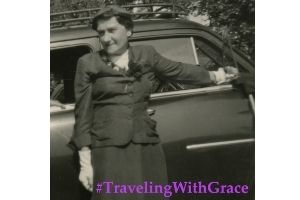
This week’s entry for our 2019 #TravelTuesday series: Traveling with Grace, follows along as she heads over the border into Mexico. As mentioned in earlier posts, the language and prejudices used in Grace’s writing are very much of her time and may be disturbing or uncomfortable to read, for instance, her description of the indigenous peoples of Mexico leaves much to be desired. To read more of Grace’s travels, click here.

Mon. July 8th. We left San Antonio at 11 AM. Reached the International bridge at Laredo about 2:30 where we had quite a long wait to get our papers O.K.’d and our baggage examined. An insurance agent was very helpful, got us a policy to cover the car while in Mexico and helped us thru the customs. The ride was rather monotonous until about an hour before we reached Monterey when we started climbing the mts. and the temperature became more agreeable.
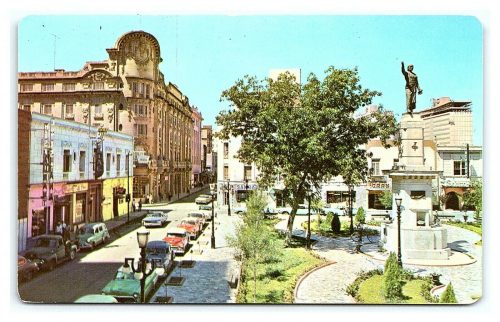
Monterey is a pretty Spanish city nestling in a circle of mts. There is a square in front of our hotel the Gran Ancira where musicians sit and serenade the tourists. The Cathedral is very imposing and this hotel quite pretty in Spanish style, beautiful paintings, heavy carved furniture, iron grill work. We have a handsomely furnished sitting room next to our bedroom. The shopping section is large and merchandise well stocked. Outside the city are beautiful orange and avocado groves and attractive haciendas. In the country we pass many Mexican cowboys with broad sombreros, on horseback. Large herds of milch goats contest the roads with the cows and we have to pull up short to avoid hitting them. It is quite hot here in the middle of the day and everyone takes a siesta, some men lying in the ditches by the road-side, others, beneath their [Tuedes???] and wagons. The little burros are heavy laden with fagots of wood or hitched to loaded wagons. There are many varieties of cacti along the way small and big, some very decorative, as well as a variety of palms and banana trees.
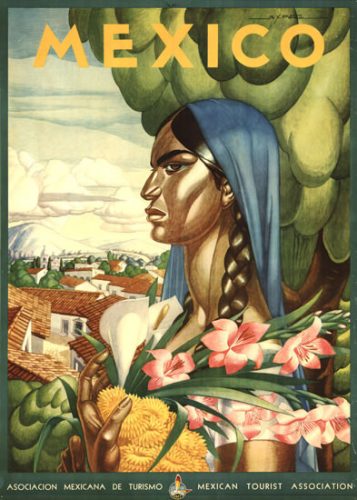
Tues. July 9th. We leave Monterey and ride 160 miles to Victoria passing only a few very small villages en route. Many names of ranches are posted along the road. Thatch-roofed cottages and queer looking rustic animal enclosures abound and here and there one sees a handsome stucco “Escuela.” The people are very friendly and courteous, smiling salutations and going out of their way to direct us. They are working on the roads everywhere which they keep in very good condition. Arrived at the Sierra Gorda hotel (Victoria) about 4. It is surprising what comfortable modern hotels they have in these small towns (35,000 inhabitants). The only mishap on the way was when our hatbox broke its moorings on the road and scattered its contents over the road but fortunately Milton saw it in time thru the rear-view mirror and salvaged nearly everything.
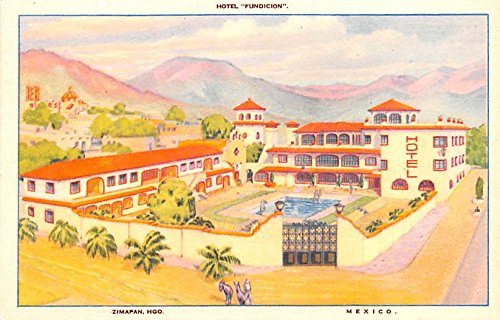
Wed. July 10. We left Victoria at 9:30 and the ride to Zimapán was one of the prettiest and most interesting I have ever had. At times we feel like we are riding thru the African jungles. The vegetation is so dense and the natives so primitive living in their grass and mud huts thatched with palm leaves the doorways open to the passing world. We can look in and see the mud lined walls and simple woven fiber chairs. Cows, pigs, chickens, goats comprise their riches. Here and there a little adobe tile-trimmed cottage looks like a palace by comparison. As we approach the mts. the scenery becomes wilder and more majestic, the roads curve sinuously upward, the valleys show intricate patchwork patters far below. Here and there a river threads thru the valley. Corn is planted right up the steep mt. side alternating with banana groves. Horses and goats climb the mt. sides like monkeys. Bright wild flowers abound. I wish I knew the names of them but I only recognize the bougainvilla and African daisies, trumpet vines and mimosa. Quaint old Spanish churches with carved images and tall belfries mark every village. After steady climbing we reached Zimapán about 6:45 a small village but the hotel Funicion is most attractive and up to date. Like all Mexican hotels it is tiled throughout, has interesting pictures by Diego Rivera in the dining room lavishly trimmed with iron grill work. A man plays the piano quite well during dinner. Later we visit the pretty little chapel and talk for a while with the other guests on the terrace. It is moonlight, the air bracing yet balmy. There is a large swimming pool on the terrace. The proprietor gave me his own room and bath on the first floor as there is no elevator.
Thurs. July 11th. Mrs. Parks came down to my room early to bring me birthday cards from the Smith-Greenhood families. We left Zimapán about 10 after a good breakfast (and I want to record here that meals so far in Mexico have been most satisfactory and far above expectations). We could not get any gasoline when we left here (had half a wank full) and Milton husbanded it with great care closing off the ignition and coasting down all the mts. At the next village we stopped expectantly at the first filling station only to be told they wouldn’t have any in the pumps until tomorrow. So with great trepidation we decided to risk it for another 10 or 12 miles and at the next village we held our breath until the filling station attendant smilingly nodded yes to our eager question and I could have kissed him. Native men and women crowded around us with large trays of different fruits balanced on their heads (it is beautiful to see how gracefully they balance all sorts of things that way) and we bought peaches and figs.
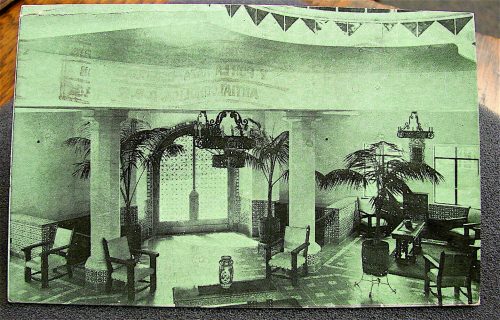
The country as we rode to Mexico City is quite different, broad cultivated fields which the peasants work in the primitive way, though one sees modern machinery in this part of the country. Palm and cactus lined highways lead to the city and 2 large statues guard the entrance where officials stop us to examine the papers for the car and we engage a licensed guide who took us right to the hotel Maria Cristina where we have bedroom, parlor and bath. We are lunch in the parlor and then the guide located a room for Milton. He took us to the Mexican Auto Ass’n, affiliate of the AAA where a lot of lovely birthday mail awaited me. Then we went on a tour of the city. Visited 3 flower markets and the guide bought me 3 corsages[?] for my birthday. At 1 of the markets we saw the most tremendous and elaborate funeral wreathes I ever saw. Visited the swanky residential section, the homes being very ornate and of a modern Spanish architecture with very little if any grounds around them. Saw the business section and bought a real leather hat box for $20 which replaces the one that fell off the car roof and smashed the other day. Mrs. Parks says it’s a bargain, no tax. Saw some beautiful monuments, parks, opera house, historical bldgs., university etc. and then feeling tired called it a day. Dinner at the hotel was good topped with strawberries which grow here 8 months of the year.
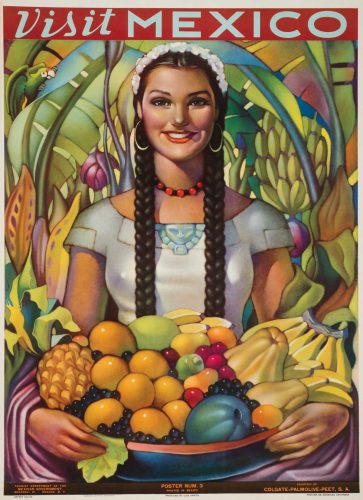
Fri. July 12. I went to the International Bank to get an Amerex changed, a very busy place. WE then bought tickets for the bull fight Sun. Next we rode to Toluca, a very pretty ride over the mts. We passed an extinct volcano. It is very cool. In Toluca a bustling town of 70,000 we saw the weekly market like which I have never seen anything before. The Indians for miles around bring in their animals, pigs, chickens, ducks, rabbits, turkeys, serapes, jackets, baskets, blankets, pottery, tortillas, fruits, sweets, the most colorful conglomeration imaginable and such crowds. Our guide just plowed his way thru them with the car and they fell away to either side like the parting asunder of the Red Sea. The faces are most interesting to study, Indian, Spanish, Mongoloid in a motley attire and all ages from tiny babies to old patriarchs, some gay and friendly with smiling faces, others stolid and impassive. They have a sort of carnival in the background with the usual midway attractions. On our way back we see women washing their clothes on stones by the river and even in the dirty stinking canals. Just before going to the trout fish hatchery we rode thru a heavy hail storm the ground quickly covered with white stones. It lightened, thundered and grew suddenly cold. At the hatchery we saw the eggs, baby fish in tanks and the full grown ones in round ponds outdoors. It is a pretty landscaped park and we ate box lunches which we bought at Sanbories[?] in a little glassed-in pavilion with tiled-topped tables. From here we visited the so called Desert of the Lions an old Carmelite monastery with tiny cells and catacombs. Here the Indians are selling their leather goods, silver, blankets and laces and there is a sort of campground with refreshment stands and sidewalk tables. A beautiful ride thru a thick forest of spruce brings us out to another attractive suburb and the guide shows us an excavation in a lava mound where bodies have been exhumed after an ancient eruption similar to what I once saw in Pompeii.
Thanks for reading “Traveling with Grace,” a series where we’re sharing (and annotating) posts from the travel diaries of Grace Amelia Hecht, native Baltimorean, b. 1897 and d. 1955. As mentioned in my introductory post transcription errors sometimes occur and I’ve made my best guesses where possible, denoted by [brackets]. – Rachel Kassman, marketing manager
